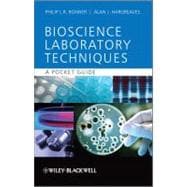
What is included with this book?
| Preface | p. ix |
| Glossary | p. xi |
| Abbreviations | p. xvii |
| The preparation of solutions in bioscience research | p. 1 |
| Introduction | p. 1 |
| Concentration | p. 2 |
| Using balances to weigh out reagents | p. 3 |
| Practical considerations when making a 1.0 M solution | p. 6 |
| Dilutions and the use of pipettes | p. 11 |
| Water, acids and bases | p. 15 |
| Buffers | p. 21 |
| The equilibrium/dissociation constant (Ka) for an acid or base and the Henderson-Hasselbalch equation | p. 24 |
| Summary | p. 26 |
| Microscopy | p. 27 |
| Introduction | p. 27 |
| Microscopes - general principles | p. 29 |
| Principles of image formation | p. 30 |
| Light microscopy | p. 32 |
| Electron microscopy | p. 46 |
| Summary | p. 49 |
| Spectrophotometry | p. 51 |
| Introduction | p. 51 |
| The electromagnetic spectrum | p. 51 |
| The absorbance of light | p. 54 |
| Absorbtion spectrophotometry | p. 56 |
| The laws of the absorbance of light | p. 57 |
| The Beer Lambert law | p. 61 |
| Spectrophotometers | p. 63 |
| Applications of spectrophotometry in bioscience | p. 68 |
| Summary | p. 73 |
| Data analysis and presentation | p. 74 |
| Introduction | p. 74 |
| Statistical analysis of data: some key definitions | p. 76 |
| Distributions | p. 79 |
| Statistical comparison of data | p. 85 |
| Presentation, structure and organization of data in laboratory reports | p. 94 |
| Summary | p. 100 |
| The extraction and clarification of biological material | p. 103 |
| General introduction | p. 103 |
| Extraction | p. 103 |
| Extraction methods for animal and plant tissue | p. 105 |
| Extraction methods for bacteria | p. 107 |
| Clarification | p. 108 |
| Centrifugation techniques | p. 115 |
| Points of good practice in centrifugation | p. 119 |
| Summary | p. 120 |
| Electrophoresis of proteins and nucleic acids | p. 121 |
| General introduction | p. 121 |
| Separation of protein mixtures by gel electrophoresis | p. 122 |
| Other electrophoretic techniques applied to proteins | p. 136 |
| Separation of nucleic acids by gel electrophoresis | p. 137 |
| Applications of gel electrophoresis of nucleic acids | p. 141 |
| Summary | p. 146 |
| Chromatography | p. 147 |
| General introduction | p. 147 |
| The theory of chromatography | p. 147 |
| Factors to consider in chromatography | p. 152 |
| Methods used to elute samples in chromatography | p. 153 |
| Different types of chromatography and what properties can be used to separate molecules | p. 153 |
| Thin layer chromatography (TLC) | p. 156 |
| High pressure liquid chromatography (HPLC) | p. 158 |
| Gas liquid chromatography (GLC) | p. 161 |
| Ion exchange chromatography (IEX) | p. 162 |
| Size exclusion chromatography | p. 164 |
| Affinity chromatography | p. 166 |
| Summary | p. 167 |
| Cell culture techniques | p. 169 |
| Introduction | p. 169 |
| Growth and maintenance of cells in culture | p. 174 |
| Summary | p. 192 |
| Suggestions for further reading | p. 195 |
| Index | p. 198 |
| Table of Contents provided by Ingram. All Rights Reserved. |
The New copy of this book will include any supplemental materials advertised. Please check the title of the book to determine if it should include any access cards, study guides, lab manuals, CDs, etc.
The Used, Rental and eBook copies of this book are not guaranteed to include any supplemental materials. Typically, only the book itself is included. This is true even if the title states it includes any access cards, study guides, lab manuals, CDs, etc.